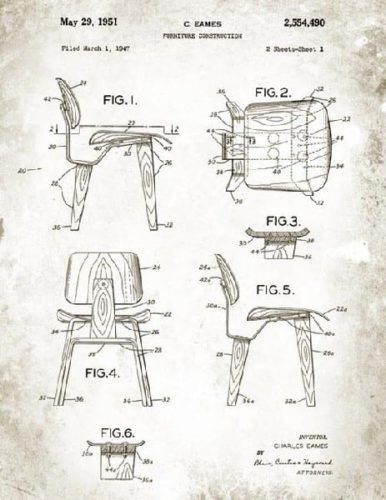Most designers, whether they make clothing, furniture, automobiles or any other non-functional ornamental products, don’t realize that they might be able to patent those designs and keep other people from using them for 14 years. Sounds pretty good right? In Part 1, I discussed the criteria required for a design patent. Now, let’s walk through a typical scenario for a furniture designer who has a new, really cool looking chair, which is about to enter the market and the company CoolChairs, Inc. who wants to make their own version.

Charles Eames Chair. Design Patent 1951
Assume you are the designer, with a small 3 person company and this is your big new product. Like most new products, the first run and second production runs are moderately low volume, making each chair fairly expensive to produce. To calculate your sale price, you must cover:
- the production costs per chair
- the research expenses, including your time, required to bring the product to market, including the costs associated with failed designs that you never brought to market
- a percentage profit that the market will bear and allows a break-even on costs in as little time as possible.
Since all this makes the retail price pretty expensive, you first market the product to affluent consumers who are early adopters of your design style. As sales pick up, you will be able to manufacture larger volume, and with those initial costs recovered, will be able to reduce the price, making the product more affordable to a wider audience. And, over time can allocate resources to expanding distribution channels to more retail stores while using the products proven popularity to cut deals with retailers.
Scenario #1: enter CoolChair, Inc. They see your design and realize the large market potential. The design has no patent protection, but to be safe, the company makes some small changes to differentiate the product in case of a lawsuit. Unlike you, CoolChair has no costs related to creating the design, nor any failed creations for which they have to recoup losses. And, they have the benefit of seeing your products initial popularity and can use that to determine probable sales. CoolChair also knows you cannot compete with their market power, distribution channels and retail relationships so they have a competitive advantage.
CoolChair also believes that since you are a small company, you won’t have the funds or ability to wage a protracted lawsuit, especially given the design changes they made. With very few obstacles in their way, Cool Chair decides on a large initial production run, including additional colors and construction materials. With a much lower cost of goods and other economies of scale, CoolChair offers its product at almost half of your retail price.
As a result of CoolChair’s actions, your design quickly shows up in retail stores all over the country. Your sales fall off quickly and dramatically. You are forced to stop further production. You sue CoolChairs but as they had guessed, you don’t have the resources for a protracted lawsuit. You end up with a small settlement resulting in a financially strapped company. Even more alarming; you realize that this same scenario may happen again and again
Now for scenario #2, in which before offering your product for sale, you apply for a design patent at the relatively minor cost of $4000. The first products out of the factory were marked with Patent Pending. Sales are very good. From here, a few different things might happen. One result may be that the patent-pending mark alerts CoolChair to your patent application, deterring them from even considering production. In another, they approach you with a lucrative licensing agreement. In another, they follow scenario #1 and start producing the chair anyway. Your response, like before, is to sue them, but this time it is for patent infringement. Given the high potential statutory awards, favorable legal standards, and possibly winning legal fees, a top attorney agrees to represent you and work on contingency, which means you can fight the case at very little cost. Immediately, the lawyer gets an injunction, stopping CoolChairs from selling the product. With the weight of fact and law in your favor, CoolChairs sees they have little chance of winning and offer a large settlement and can never sell your designs again. You accept it. Your exclusive right has value and enables you to create a successful licensing agreement with another large furniture retailer. They eventually buy your patent outright.
The point of all of this is that the design patent is more than just protection but has its own monetary value and power. As I have often mentioned in my articles on Trademark and copyright, think of intellectual property protection as an insurance policy. As design patents are more expensive than a trademark or copyright registration, you have to weigh the possibility of someone stealing your design vs. the potential market loss and see if it makes sense. Hopefully, though, now you have enough information to consider the issue wisely.
If you have any questions regarding design patents or any other intellectual property matter, just send me an email at [email protected]. If you find this article interesting, please share it with your friends by clicking the Share button on the left and help us build our audience.
